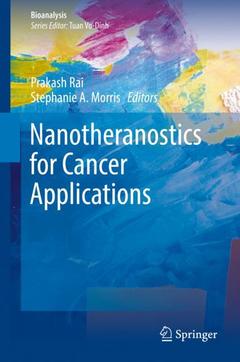Description
Nanotheranostics for Cancer Applications, 1st ed. 2019
Bioanalysis Series, Vol. 5
Coordinators: Rai Prakash, Morris Stephanie A.
Language: English
Subjects for Nanotheranostics for Cancer Applications:
Support: Print on demand
Description
/li>Contents
/li>Biography
/li>Comment
/li>
This book is the first to focus specifically on cancer nanotheranostics. Each of the chapters that make up this comprehensive volume is authored by a researcher, clinician, or regulatory agency member known for their expertise in this field.
Theranostics, the technology to simultaneously diagnose and treat a disease, is a nascent field that is growing rapidly in this era of personalized medicine. As the need for cost-effective disease diagnosis grows, drug delivery systems that can act as multifunctional carriers for imaging contrast and therapy agents could provide unique breakthroughs in oncology. Nanotechnology has enabled the development of smart theranostic platforms that can concurrently diagnose disease, start primary treatment, monitor response and initiate secondary treatments if required. In oncology, chemotherapeutics have been routinely used. Some drugs have proven effective but all carry risks of adverse side effects. There is growing interest in using remotely triggered drug delivery systems to limit cytotoxicity in the diseased area.
This book reviews the use of theranostic nanoparticles for cancer applications over the past decade. First, it briefly discusses the challenges and limitations of conventional cancer treatments, and presents an overview of the use of nanotechnology in treating cancer. These introductory chapters are followed by those exploring cancer diagnosis and a myriad of delivery methods for nanotherapeutics. The book also addresses multifunctional platforms, treatment monitoring, and regulatory considerations. As a whole, the book aims to briefly summarize the development and clinical potential of various nanotheranostics for cancer applications, and to delineate the challenges that must be overcome for successful clinical development and implementation of such cancer theranostics.
Part I: Introduction to Cancer and Nanotechnology
1. Introduction (Praveena Velpurisiva, Janel L. Kydd, Rahul Jadia, *Stephanie A. Morris, and *Prakash Rai)
2. Biological Events and Barriers to Effective Delivery of Cancer Therapeutics (Erica N. Bozeman and *Lily Yang)
3. Cancer Diagnostics and Therapeutics (*Uma Prabhakar, Yalia Jayalakshmi, and C. Katherine Wang)
4. Nanomedicine in Cancer (Liang Ma, Phuong Le, Manish Kohli, and *Andrew M. Smith)
5. Theranostics: A Historical Perspective of Cancer Nanotechnology Paving the Way for Simultaneous Use Applications, (Christopher M. Hartshorn and *Stephanie A. Morris)
Part II: Cancer Nanodiagnostics and Nanotherapeutics
6. In Vitro Cancer Diagnostics (Jung-Rok Lee, Chi Chun Ooi, and *Shan X. Wang)7. Translational Nanodiagnostics for In Vivo Cancer Detection (*Christina H. Liu, *Pushpa Tandon, and Luisa M. Russell)
8. Delivery of Cancer Nanotherapeutics (Bomy Lee Chung, Joseph Kaplinsky, Robert Langer, and *Nazila Kamaly)
9. Oral Nanotherapeutics for Cancer with Innovations in Lipid and Polymeric Nanoformulations (Alexander J. Donovan and *Ying Liu),
10. Topical and Transdermal Nanomedicines for Cancer Therapy (Yanqi Ye, Jinqiang Wang, Wujin Sun, Hunter N. Bomba, and *Zhen Gu)
11. Cancer Nanotherapeutics Administered by Non-Conventional Routes (Kyle C. Roche, Yusra Betul Medik, Zach Rodgers, Sam Warner, and *Andrew Z. Wang)
Part III: Regulatory Considerations for Nanomaterial Drug Products
12. Regulatory Considerations for Cancer Drug Products Containing Nanomaterials (Mamta Kapoor, Kathryn Hughes, and *Katherine M. Tyner)
13. Perspectives for Characterizing Drug Component of Theranostic Products Containing Nanomaterials (*Christie Sayes and Anthony Hickey)
Part IV: Cancer Nanotheranostics
14. Engineering Multifunctional Nanomedicine Platforms for Drug Delivery and Imaging (James Grant, Mana Naeim, Youngshin Lee, Darron Miya, Theodore Kee, and *Dean Ho)
15. Image-Guided Drug Delivery (Camila Gadens Zamboni, Keyvan Farahani, and *Jordan J. Green)
16. Nanotheranostics-Based Imaging for Cancer Treatment Monitoring (Tianxin Miao, Rachael A. Oldinski, *Gang Liu, and *Xiaoyuan Chen)17. Remotely-Triggered Nanotheranostics (Abdul K. Parchur, Jaidip M. Jagtap, Gayatri Sharma, Venkateswara Gogineni, *Sarah B. White, and *Amit Joshi)
18. Concluding Remarks and the Future of Nanotheranostics (Janel L. Kydd, Praveena Velpurisiva, *Stephanie A. Morris, and *Prakash Rai)
Stephanie Morris, PhD joined the National Institutes of Health (NIH) as a Program Director at the National Cancer Institute in 2012 where she managed a portfolio of nanotechnology research projects and centers in the Alliance for Nanotechnology in Cancer program. She also developed new research initiatives such as the Innovative Research in Cancer Nanotechnology program and participated on several NIH and interagency committees and working groups, especially those focused on nanotechnology data sharing. She received her Bachelor's degree in Biology and Neuroscience and Behavior (dual majors) from Wesleyan
Provides a comprehensive review of cancer nanotheranostics
Represents the first book-length treatment of the topic
Presents a full picture of the field, from basic research through clinical implementation
Features evidence-based chapters with excellent illustrations and images to guide and assist the reader
These books may interest you

Cancer NanotheranosticsVolume 2 168.79 €



